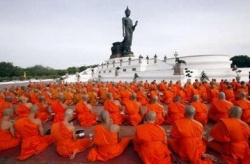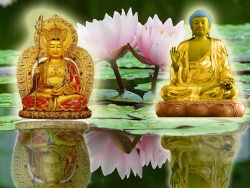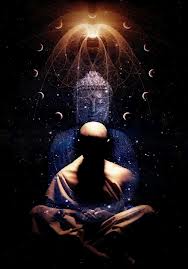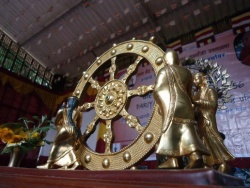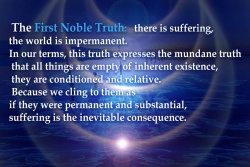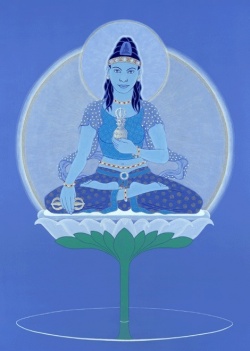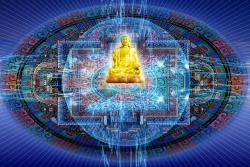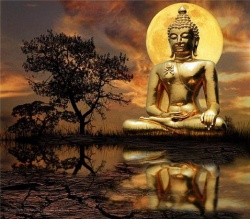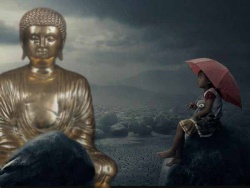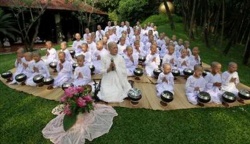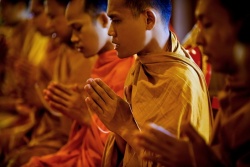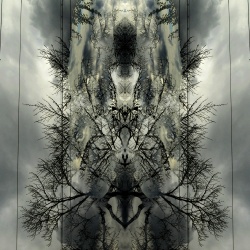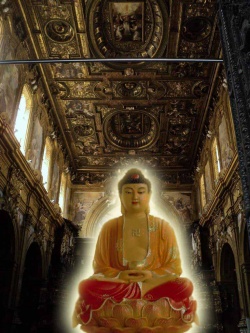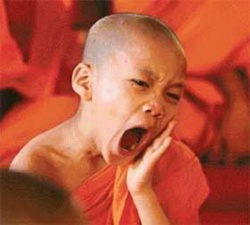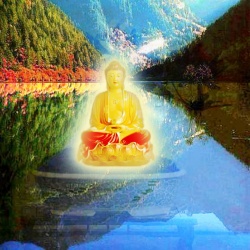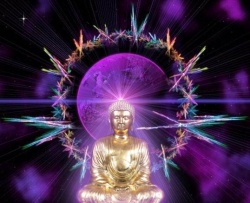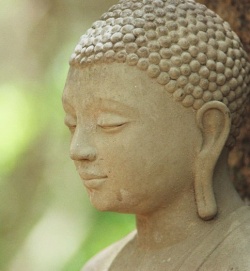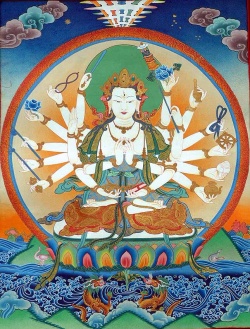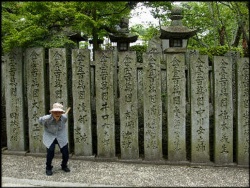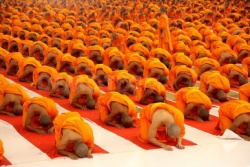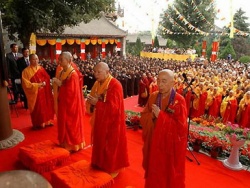Four Buddhist Councils
The First Council
According to Pali tradition recorded in canonical and non-canonical literature three Sangitis (recitals) or Councils were held to draw up the canonical text and the creed in their pure form. The first council was held at Rajagrha immediately after the parinirvana of the Buddha. It is accepted by critical scholarship that the First Council settled the Dhamma and the Vinaya and there is no ground for the view that the Abhidhamma formed part of the canon adopted at the First Council. It is held that Mahakassapa presided over the assembly in which Upali and Ananda took an important part. There was seldom dissension over doctrinal matters but Council was necessitated by the pious determination of the disciples of the Lord to preserve the purity of his teaching.
The tradition preserved in the 11th khandhaka of the Cullavagga has been accepted as authoritative in the different accounts found in extra-canonical literature such as the Dipavamsa and the Mahavamsa.
It is asserted in the Cullavagga that Mahakassapa was not present at the mahaparinirvana of the Buddha at Kushinagara. While he was proceeding from Pava to Kushinagara with a large retinue, the news of the decease of the Master was brought to him by a naked ascetic of the Ajivika sect. It is recorded that a thera called Subhadda exhorted the monks who were vociferous in their lamentations, to refrain from expressing grief, and called upon them think the occasion a good riddance. Since they were treated as so many schoolboys by the Master, who often admonished them for their unbecoming conduct, they would now be free to do as they thought fit without let or hindrance. This irreverent remark filled the Venerable Mahakassapa with alarm for the future safety and purity of the Dhamma preached by the Master. Mahakassapa also had other reasons for anxiety as pointed out in the Mahavamsa.1 He received the garment of the Master as a token of authority equal to that of the Master and was determined to fulfil the Master’s command to establish the holy truth. The remark of Subhadda was a clear indication of the necessity of convening a Council for the fulfilment of this noble objective.
It may be observed in this connection that Subhadda was not the only person to have such thoughts. There were many others who felt that with the passing of the Master the Dhamma, he had taught, would disappear. The account in the Tibetan Dulva and also that of Yuan Chwang refer to this general feeling of doubt and consternation as having been motive for the convocation of the First council.
After some deliberation the town of Rajagrha was selected for the meeting of the Council. It is said that the Council was held near the Saptaparni Cave, though according to the Tibetan Dulva it is supposed to have taken place at the Nyagrodha Cave. The authority of the Cullavagga, however, need not be called in question and it has been followed by almost all subsequent accounts.
The Lokottaravada account places the venue of the Council on the northern side of Mount Vebhara (or Vaibhara), while in Asvaghosa’s account, the Indrasala Cave of Mount Grdhrakuta is mentioned. It is stated in the Pali Chronicle that the Saptaparni Cave was situated on the side of Mount Vebhara and that a pandal was erected at the instance of King Ajatashatru outside of this cave. The site of the cave, however, has not yet been definitely identified. None the less, there is no dispute about the fact that it is at Rajagrha that the First Council met. It was evidently selected because accommodation was plentiful and there was no difficulty about supplies. It is also said in the Dulva the Rajagrha was selected because King Ajatashatru was a firm believer in the Buddhist faith and that he would, therefore, make ample provision for food and lodge. The accounts in the Mahavamsa and Samanta-pasadika lend support to this assertion. Hence, the omission of the name Ajatashatru in the Cullavagga need not be regarded as evidence against the authenticity of this account.
The meeting actually took place in the second month of the rainy season. In the Samanta-pasadika we find a detailed description of the ceremonies which took place about six weeks before the actual opening of the season. Allowing for natural exaggerations, it may be affirmed that Mahakassapa took the initiative and chose four hundred and ninety-nine bhikkhus to from the Council. It is stated in the Cullavagga and confirmed in the Dipavamsa that the number of monks was chosen in pursuance of a vote by the general congregation of monks assembled on the occasion and at the place of the parinibbana of the Master.
There is general agreement that the number of the monks selected was five hundred. Yaun Chwang, however, makes it a thousand which may be an excusable exaggeration considering the long interval between the event and Yuan Chwang’s time.
There was, however, some protest regarding the omission of Ananda from the number of councillors chosen. In the Cullavagga, it is stated that the Bhikkhus strongly interceded for Ananda, though he had not attained Arhathood, because of the high moral standard he had reached and also because he had learnt the Dhamma and the Vinaya from the Master himself.
Ananda was eventually accepted by Mahakassapa as a result of motion on the part of the monks. The procedure followed regarding Ananda has, however, given rise to a controversy. It will be observed that Ananda was brought to trial in the course of the proceedings. The Dulva, however, places the trial before the meeting of the Council. The account of the Cullavagga is followed by the Vinayas of the Mahisasakas and Mahasanghikas and declares that Ananda had to meet certain charges after the recital of the Dhamma and the Vinaya, but there is no allusion to Ananda’s failings in the Dipavamsa, and the Mahavamsa, Buddhaghosa’s Samanta-pasadika and the Mahavastu Proceedings of the Council.
The procedure followed at the Council was a simple one. With the permission of the Sangha, the Venerable Mahakassapa asked questions on the Vinaya of the Venerable Upali. All these questions related to the four Parajikas, the matter, the occasion, the individual concerned, the principle rule, the amened rule as well as to the question as to who would be guilty and who innocent of these Parajikas. In this way the Vinaya text was agreed upon at the Council.
The turn of Ananda came next. The subject matter of the sutta-pitaka, in all the five Nikayas, was formulated as questions for Ananda who gave appropriate answers. These questions followed the lines adopted in those of the Vinaya- the occasion of the sermons and the person or persons with references to whom they were given. The answer given by Ananda settled the corpus of Sutta-pitaka.
Buddhaghosa in the samanta-pasadika, the entire business of the Council is said to have been conducted by Mahakassapa, Upali and Ananda. The Dipavamsa, however, gives a more representative character to the proceedings and the results achieved. The texts are said to have been complied by the bhikkhus followed the lead of Upali in the Vinaya and that of Ananda in respect of the Dhamma. The works as arranged and settled are ascribed to the collective authorship of the whole Council of bhikkhus.
The account given in the Mahavastu differs materially from the Pali tradition. It is said that Katyayana was the leading exponent and the subject of the discourse was Dasabhumis. The Mahavastu, however, is the Vinaya of the Lokottaravadins, a sect which came into existence long after the Mahasanghikas had brought about the schism in the Church.
There is, however, no mention of the Abhidamma-pitaka as having been a subject of discussion at the First Council. In later literature however questions were raised regarding the authenticity of the Abhidhamma as an integral part of the Cana, and this is significant.
Charges against Ananda
As already mentioned, there was considerable agitation over the admission of Ananda to the Synod. Mahakassapa is said to have entertained misgivings regarding his admission on the ground of his failure to reach Arhathood, which he did actually reach on the eve of the session of the Council. But in spite of this achievement and of the belief and convention that the attainment of Arhathood emancipates a man from all guilt and punishment, Ananda was arraigned by the monks on several charges which he explained as follows:
(1) He could not formulate the lesser and minor precepts, as he was overwhelmed with grief at the imminent death of the Master.
(2) He had to tread upon the garment of the Master while sewing it as there was no one to help him.
(3) He permitted women to salute first the body of the Master, because he did not want to detain them. He also did this for their edification
(4) He was under the influence of the evil one when he forgot to request the master to enable him to continue his study for a kalpa
(5) He had to plead for the admission of women into the Order out of consideration from Mahaprajapati Gautami who nursed the Master in his infancy.
The charges are differently framed in the other Vinayas. According to the Dulva, two other charges also seem to have been brought against Ananda, first that he failed to supply drinking water to the Buddha though he had thrice asked for it and secondly, that he showed the privy parts of the Buddha to men and women of low character. His replies were (6) that the water of the river was muddy, and (7) that the exhibition of the privy parts would rid those concerned of their sensuality. These replies may be taken as having satisfied the Assembly.
Another important item of business transacted at the First Council was the passing of the highest penalty (Brahmadanda) on Channa who was the charioteer of the master on the day of the Great Renunciation. This monk had slighted every member of the Order, high and low, and was arrogant in the extreme. The penalty imposed was complete social boycott. When the punishment was announced to Channa he was seized with profound repentance and grief and was purged of all his weaknesses. In short, he became an Arhat. The punishment automatically ceased to be effective.
Briefly, the proceedings of the First Council achieved four results: (1) the settlement of the Vinaya under the leadership of Upali, (2) the settlement of the texts of the Dhamma under the leadership of Ananda, (3) the trial of Ananda, and (4) the punishment of Channa.
There is, however, a difference between the account of the Cullavagga and that of the Dulva regarding the trial of Ananda. According to the former, the trial took place practically after the conclusion of the main business, whereas in the Dulva it comes before his admission to the Council.
Prof. Oldenberg is sceptical about the historical authenticity of the First Council. The irreverent remark of Subhadda is also found in the Mahaparinibbana-sutta, but there is not the slightest allusion to the holding of the Council. This doubt based on omission is at best an argumentum ex silentio. The unanimous tradition among all the schools of Buddhism cannot therefore be brushed aside as a pious fabrication. In spite of the minor discrepancies there is a substantial core of agreement regarding the convention of the First Council, which was a logical and ecclesiastical necessity. It was natural that the creed of the Church should be determined in a systematic way after the passing of the Master. Fortunately, Prof. Oldenberg appears to plough a lonely furrow. Scholars; both Eastern and Western, are all united in their rejection of this scepticism.
The Second Council
The second council was held at Vaisali a century after the passing of the Master. The time recorded should be taken as a round number. It is recorded in the Cullavagga that the monks of the Vajji country were in the habit of practising the ten Points (dasa vatthuni) which were regarded as unorthodox by Yasa, the son of Kakandaka. He declared these practices to be illegal and immoral in the extreme. The Vajji monks, however, pronounced the penalty of patisaraniyakamma upon him. This necessitated the offender’s apologizing to the laity who had been forbidden by Yasa to carry out the precepts of the Vajji monks.
Yasa defended his own view before the laity and by his eloquent advocacy won them over to his side. This increased the fury of the offending monks who pronounced the punishment of ukkhepaniyakamma upon him, which meant his virtual expulsion from the Brotherhood.
The ten Points or Indulgences described in the Cullavagga are as follows:
(i) Singilonakappa, or the practice of carrying salt in a horn. This practice is contrary to pacittiya 38 which prohibits the storage of food.
(ii) Dvangulakappa, or the practice of taking meals when the shadow is to fingers broad. This is against pacittiya 37 which forbids the taking of food after midday
(iii) Gamantarakappa, or the practice of going to another village and taking a second meal there on the same day. This is opposed to pacittiya 35 which forbids over-eating.
(iv) Avasakappa, or the observance of the Uposatha ceremonies in various places in the same parish. This practice contravenes the Mahavagga rules of residence in a parish (sima).
(v) Anumatikappa, or obtaining sanction for a deed after it is done. This also amounts to a breach of monastic discipline.
(vi) Acinnakappa, or using customary practices as precedents. This practice is in contravention of pacittiya 35 which prohibits over-eating.
(vii) Amathitakappa, or the drinking of buttermilk after meals. This practice is in contravention of pacittiya 35
(viii) Jalogim-patum, or the drinking of toddy. This practice is opposed to pacittiya 51 which forbids the drinking of intoxicants.
(ix) Adasakam-nisidanam, or using a rug which has no fringe. This is contrary to pacittiya 89 which prohibits the use of borderless sheets.
(x) Jataruparajatam, or the acceptance of gold and silver which is forbidden by rule 18 of the Nissaggiya-pacittiya.
The Venerable Yasa openly declared these practices to be unlawful. After the sentence of excommunication had been passed on him, he went to Kausambi and sent messengers to the bhikkhus of the Western Country and of Avanti and of the Southern Country, inviting them to assemble and decided the question in order to arrest the growth of irreligion and ensure the preservation of the Vinaya.
Next, he proceeded to the Ahoganga hill where Sambhuta Sanavasi dwelt. He saluted the venerable monk and expounded the ten Thesis advocated by the Vajjian monks. He invited him to take up this question in earnest. The Venerable Sanavasi agreed to do so. About the same time some sixty Arhats came from the Western Country and assembled on the Ahoganga hill. About eighty-eight from Avanti and the Southern Country also joined them. These monks declared the question to be hard and subtle. They thought of the Venerable Revata who was at Soreyya and was celebrated for his learning and piety. They proposed to meet him and enlist his support. After a good deal of travelling they met the Venerable Revata at Sahajati. On the advice of Sambhuta Sanavasi, he approached the Venerable Revata and placed the issue before him. One by one, Bhikkhu Yasa brought up the Ten Points and asked for his opinion. Each one them was declared to be invalid by the Venerable Revata.
Meanwhile, the Vajjian monks were not idle. They also went to Sahajati in order to enlist the support of the Venerable Revata. They offered him rich presents which the Venerable Revata refused with thanks. However, they induced his disciple, Uttara, to take up their cause, but failed. At the suggestion of revata, the monks proceeded to Vaisali in order to settle the dispute at the place of its origin. Seven hundred monks met in a Council, but there was much rambling talk and fruitless discussion. In order to avoid further waste of time and irrelevant discussion, the matter was referred to a committee consisting of four monks from the East and four from the West. Bhikkhu Ajita was appointed the seatregulator. The Venerable Sabbakami was elected president. The Ten Points were put one by one and they were declared unlawful. The questions were stated again and the same decision was arrived at in the full assembly of the Council.
The unanimous verdict of the assembly declared the conduct of the Vajjian monks to be unlawful.
The account given above is taken from the Cullavagga. The accounts in the Mahavagga and the Dipavamsa add certain points and raise the number of the bhikkhus to an extraordinarily high figure. According to the Dipavamsa and the Samanta-pasadika, the Council was held in the reign of King Kalashoka, a descendant of Ajatashatru. Kalasoka, though formerly in favour of the Vajjian monks, was prevailed upon to give his support to the Council of the Theras. The Dipavamsa mentions that the bhikkhus of Vaisali held another Council which was attended by ten thousand monks. It was called the Great Council (Mahasangiti). According to the Mahavamsa, a council of seven hundred theras compiled the Dhamma. In the Samanta-pasadika, Buddhaghosa observes that after the final judgement, the seven hundred bhikkhus engaged in the recital of the Vinaya and the Dhamma and drew up a new edition resulting in the Pitakas, Nikayas, Angas and Dharmaskandhas.
There are slight divergences in the Chinese and Tibetan versions. The northern version generally puts the date of the Council 110 years after the nirvana of the Buddha. In spite of these minor differences there is substantial agreement on the genesis of the Council and the matters discussed and decided. Prof. Oldenberg, however, throws doubt on the genuineness of the Council on the ground that the Vinaya text does not take note of the propositions discussed at Vaisali, but these points are neither positive nor strong enough to prove the unanimous tradition of the Buddhist schools to be an invention of later writers. The story of the Second Council has every reason to be accepted as genuine. It resulted in a schism in the Buddhist Church and the session of the Mahasanghikas which is confirmed by later evidence. 2
The Third Council
The Third Council was held at Pataliputra under the aegis of the celebrated Buddhist monarch, Priyadarsi Ashoka. Ashoka was won over to the Buddhist faith within a few of his accession to the throne. The occasion for the Third Council was supplied by the need to establish the purity of the Canon which had been imperilled by the rise of different sects and their rival claims, teachings and practices. According to Kern, the Third Council was not a general Council but a party meeting of the Sthaviravadins or Vibhajjavadins. Tissa Moggaliputta, who is reputed to have converted the Emperor to the Buddhist faith, was pained to observe the corrupt practices that had crept into the Brotherhood and the heretical doctrines preached by sectarians of various descriptions. He succeeded in subduing the heresies and expelling the sectarians from the Church. The most significant outcome of the Council was that he restored the true faith and propounded the Abhidamma treatise, the Katha-vatthu, during the session of the Council.
There is an account of the miraculous birth of Moggaliputta Tissa and his conservation to the Buddhist faith in the Mahavamsa. The cardinal points in the life of Tissa are that he was born in a Brahmin family and learned the three Vedas before he was sixteen. He was, however, won over to the new faith by Thera Siggava and very soon attained to Arhatship with all its attendant supernatural powers. It was under his influence that the Emperor made over to the Buddhist faith.
With the conversation of Ashoka, the material prosperity of the monasteries grew by leaps and bounds and the monks lived in ease and comfort. The heretics who had lost their income and honour were attracted by these prospects to enter their own old faiths and practices and preached their doctrines as the doctrines of the Buddha. This caused extreme distress to Thera Moggaliputta who retired to a secluded retreat on the Ahoganga mountain up the Ganges and stayed there for seven years.
The numbers of the heretics and false monks became far larger than that of the true believers. The result was that for seven years no Uposatha or Pavarana ceremony was held in any of the monasteries. The community of the faithful monks refused to observe these festivals with the heretics. The Emperor was filled with distress at this failure of the Brotherhood and sent commands for the observance of the Uposatha.
A grievous blunder was committed by the Minister who was entrusted with task. He misunderstood the command and beheaded several monks for their refusal to carry out the King’s order. When this sad news was reported to Ashoka he was seized with grief and apologized for this misdeed. He asked the Brotherhood whether they held him responsible. Some thought him guilty, some not. The King was perplexed and enquired if there was any among the monks who could set his doubts at rest. They all said that only Thera Tissa, the son of Moggali, could answer his question. Thereupon the King sent messengers to the monks asking him to come down to Pataliputra.
After several unsuccessful attempts, the Elder Tissa was prevailed upon to consent to journey by boat. On the arrival of the great monk, the monarch himself came forward to receive him. He went knee deep into the water and extended his right hand to the Thera as a token of great reverence.
The Venerable monk instructed the King in the holy religion of the Buddha for a week. The King thereafter convoked as assembly of the whole community of bhikkhus. He called the bhikkhus of several persuasions to his presence and asked them to expound the teachings of the Blessed One. They set forth their misguided beliefs, such as the doctrine of the eternal soul, and so on. These heretical monks numbering sixty thousands were expelled from Brotherhood by the King. He thereafter interrogated the true believers about the doctrine taught by the Blessed One and they answered that it was Vibhajjavada (the religion of analytical reasoning). When the Thera corroborated the truth of this answer, the King made the request that the Brotherhood should hold the Uposatha ceremony so that the whole community might be purified of evil elements. The Thera was made the guardian of the Order.
Thera Tissa thereafter elected a thousand bhikkhus of the Brotherhood who were well versed I the three Pitakas to make a compilation of the true doctrine. For nine months he worked with the monks and the compilation of the true Tripitaka was completed. This council was held in the same manner and with the same zeal as those of Mahakassapa and Thera Yasa respectively. In the midst of the Council Thera Tissa set forth the Kathavatthu-pakaran wherein the heretical doctrines were thoroughly examined and refuted. Thus ended the Third council in which a thousand bhikkhus took part.
One of the momentous results of this Council was the despatch of missionaries to the different countries of the world foe the propagation of the Saddhamma. Mahinda, the son of Ashoka, and Sanghamitta, his daughter, were charged with missionary work in the island of Ceylon. We have already mentioned the singular success of this mission in that island, from the edicts of Ashoka we know of the various Buddhist missions he sent to far-off countries in Asia, Africa and Europe. It is to a large extent due to these missionary activities that Buddhism became the ruling religion of a large part of mankind.
The Fourth Council
The Fourth Council was held under the auspices of Kanishka who was a powerful King of the Saka or Turuska race. He held sway over a wide tract of the country including Kabul, Gandhara, Sindh, North-West India, Kashmir and part of Madhyadesa. He was esteemed as highly by the Northern Buddhists as was Ashoka. From numismatic evidence it appears that originally he was Ashoka. From numismatic evidence it appears that originally he was an adherent of some form of Iranian religion and was later converted to the Buddhist faith. Though we have no indisputable evidence of the date of his conversion, it is almost certain that the date of the Council held under his inspiration and patronage was about 100 A.D The place of the Assembly was, according to one authority, Jalandhar, and according to another, Kashmir.
The Southern Buddhists do not recognize this Council and there is no references to it in the Chronicles of Ceylon. It would not be wrong to assume that the Buddhists of Theravada schools did not participate in the Council. According to a Tibetan record, one of the results of the Council was the settling of the dissensions in the Brotherhood. The eighteen sects were all acknowledged to be the repositories of the genuine doctrine. According to Yuan Chwang, King Kanishka became interested in the Buddhist scriptures and sent for a monk every day to give him instruction but, as the instruction differed and was often contradictory, the King was perplexed and consulted the Venerable Parsva about the true doctrine. It was on his advice that he decided to convoke a Council in which the various sects would be represented. He was anxious to put an end to the dissensions in the Church. The King built a monastery for the accommodation of 500 monks who were called upon to write commentaries on the Pitakas. The commentary on the Sutta-pitaka was composed in 100,000 slokas. The Vinayavibhasa, a commentary on the Vinaya, also consisted of 100,000 slokas, and the Abhidharma-vibhasa, which was composed in the Council, also ran to the same number.
The proceeding of the Council were thus confined to the composition of the commentaries. And it appears also that the doctrines which enlisted the greatest common measure of agreement were the most strongly stressed. It appears also that the monks of the Sarvastivada School predominated at the Council. It is also highly probable that the major subdivisions of the Sthaviravada schools including the less orthodox sections were also represented in fair number. There is no evidence that Mahayana Buddhism was represented in the proceedings, as it came into prominence only after the birth of Nagarjuna which was after the Council. The Rajatarangini holds that Nagarjuna which was after the Council. The Rajatarangini holds that Nagarjuna flourished after the rule of the Turuska kings.
Yuan Chwang reports that after the treaties were composed they were inscribed on copper plates and enclosed in stone boxes which were deposited in a tope made for the purpose. “The most significant trait of the Third Council,” says Kern, “is that it closed a period of old quarrels between the sects; it did not prevent the rise of new aspirations.”
Though the details appear to be exaggerated, it would not be reasonable to disbelieve entirely the tradition which persisted among the Northern Buddhists regarding the historical truth of the Fourth Council. We therefore demur to accept the view of La Vallee Poussin that it was “an apologetic quasi-invention.” The fact that Yuan Chwang records the occurrence of the Council after a lapse of five centuries, and that the records in the Tibetan Chronicles bearing testimony to the convocation of the Council are of still later date, does not warrant complete scepticism.
It is a matter of regret that Yuan Chwang and the Tibetan chroniclers do not expressly mention the medium in which the works were composed. It is not unreasonable to suppose that Sanskrit was the language used at the proceedings. In fact the Abhidharma-Kosa of Vasubandhu is based upon these Vibhasas, and the commentary of Yashomitra cites ipsissima verba from old Vibhasa literature.
Furthermore, the discovery of the work of Ghosaka, the Abhidharmamrta, which is not far removed from the time of Kanishka, should clinch all controversy. The Fourth Council may thus be regarded as an epoch-making event in the history of Buddhism in that it made Sanskrit the vehicle of Buddhist scriptures. “All accounts are silent on the idiom of the sacred texts approved or revised at the Third Council, but from the silence we must not infer that the Chinese pilgrims had no notion of a Canon that was written in another language but Sanskrit. It is an untoward circumstance that all works of the old Canon, the Tripitaka in the proper acceptation of the term, so far as they have been preserved, are the only known through translations of Sanskritized text.3 These words of Kern deserve careful consideration, and perhaps sound a warning against hasty dogmatism.
APPENDIX I
Councils in Ceylon (Sri Lanka)
According to the Mahavamsa and other Ceylonese traditions three Councils were held in Ceylon.
The first of these was held during the reign of King Devanampiya Tissa (247-207 B.C.) under the presidentship of the Venerable Arittha Thera. This Council was held after the arrival in the island of Buddhist missionaries, headed by Thera Mahinda, a son of Emperor Ashoka. According to tradition, sixty thousand Arhatas took part in the assembly, and as desired by Thera Mahinda, the Venerable Arittha, a Simhalese bhikkhu, recited the canon. Thera Arittha is considered to be the first pupil of Mahinda in the line of the Simhalease Theras and seventh in succession of the Acarya-parampara (lineage of teachers). The Council took place at the site of the Thuparama in Anuradhapura.
In spite of this, the next Council which was held during the time of king Vattagamani Abhaya (101-77)4 is considered to be the Fourth by the Theravada school although, in India, kanishka’s council was recognized as the Fourth.
According to the Simhalese tradition, not only was the Tripitaka rehearsed, but its commentaries were revised, recast and arranged subject-wise. It is said that as Buddhist religious practice and culture were threatened by growing materialism and the moral decline of mankind through wars and families, the learned Mahatheras decided to hold this synod so that the entire Canon and the commentaries might be committed to writing. At the end of the Council, the texts along with the Attha-kathas were inscribed on palm leaves and the scriptures were checked over a hundred times.
As many as 500 learned bhikkhus took part in the deliberations under the presidentship of Mahathera Rakkhita. This is called the Alu-vihara or the Alokavihara Council as it was held at Aloka Cave in the village of matale in Ceylon. It is said that for the most part, it was patronized by a Minister of the King.
About a century ago, in 1865. A.D. another council was held at Ratnapura in Ceylon under the presidentship of the venerable Hikkaduve Siri Sumangala. It continued for five months and was patronized by Iddamalgoda Basnayaka Nilame.
APPENDIX II
Councils in Thailand (Siam)
The Sangitivamsa 4, or the History of the Recitals, written by a royal Thai patriarch named Somdej Phra Vanarat (Bhadanta Vanaratana) during the reign of Rama I, in B.E. 2332 (1789 A.D.), records as many as nine Councils. Of these nine Councils, the first three were held in India, the fourth, fifth, sixth and seventh in Ceylon, and the eighth and ninth in Thailand. The history of the five Councils including the first two of Ceylon is the same as that in the Mahavamsa and other Simhalese traditions. The remaining two councils, as described in the Sangitivamsa, were not Councils in the true sense of the term.
The Sixth Council in Sri Lanka
The Sixth Council, as mentioned in the Sangitivamsa, was held during the reign of the King Mahanama in B.E. 516 in which only the commentaries were translated from Simhalese into Magadhi (Pali) by Bhadanta Buddhaghosa whose scholarship had been tested in many ways by the gods and the learned bhikkhus of Ceylon.
The Seventh Council in Sri Lanka
The Seventh Council is said to have revised only the commentaries of the Tripitaka of the Mahatheras and finally these were recited at the Council held under the presidentship of the Venerable Mahakassapa. This took place in B.E 1587 in the reign king Parakramabahu the Great. The Conference, which took place in the royal palace, lasted a year.
The Eighth Council in Thailand
In order to establish Buddhism on a firm basis, King Sridharmacakravarti Tilaka Rajadhiraja, the ruler of Northern Thailand called this Council in Chiengmai, his capital. The Assembly was held in Mahabodhi Arama between 2000 and 2026 B.C. and continued for a year. All the learned monks in Thailand took part in this Council.
The Ninth Council in Thailand
This Council was held in Bangkok in B.E. 2331, after a war between Thailand and a neighbouring kingdom. The old capital Ayuthia (Ayodhya), was destroyed by the fire and many books and manuscripts of the Tripitaka were reduced to ashes. Moreover, the brotherhood was disorganized and morally weakened by reason of the prolonged hostilities. King Rama I and his brother were perturbed at the moral laxity of the Sangha. They consulted the learned brethren I order to convene a Council so that the faith might be restored. Under the royal patronage 218 Elders and 32 lay scholars assembled together and continued the recitation of the Tripitaka for about a year. During and after this Council, the revival of Buddhism was I full swing in Thailand. Monasteries were rebuilt and pagodas were restored. Owing to the enthusiasm of the general public many new monasteries and temples were also built.
APPENDIX
Councils in Burma
The first three Councils having been in India and the fourth in Ceylon (Sri Lanka) where Pali books were committed to writing, the Fifth was held in order to prepare a uniform edition of the Pali Canon and to record it on marble slabs. This great Buddhist Council was convened at Mandalay in 1871 A.D. (B.E. 2414) under the teachers participated. The Elders Jagarabhivamsa, Narindabhidhaja and Sumangala Sami presided in turn. The recitation and recoding of the Tripitaka on marble continued for about five months in the royal palace. Various available editions of the Tripitaka were used for comparison and colation by the learned Mahatheras, and the recording done on as many as 729 marble slabs selected for the purpose.
The Sixth Buddhist Council
The Sixth Buddhist Council was inaugurated in May 1954, in Rangoon, with the collaboration and participation of the learned bhikkhus of the various countries of the world particularly India, Ceylon, Nepal, Cambodia, Thailand, Laos and Pakistan. The Venerable Abhidhaja Maharattha Guru Bhadsnta Revata presided.
About 500 bhikkhus from Burma, well versed in the study and practice of the teachings of the Buddha, were invited to take the responsibility for re-examining the text of the Tripitaka. Similar groups of monks were organized in each of the Buddhist countries to examine the texts of the Tripitaka. The Great Council that was inaugurated in 1954 was to go till the completion of its task at the full moon of Vaisakha, 1956, that is, the 2,500th anniversary of the Buddha’s mahaparinirvana. It is believed that this anniversary will bring about a great revival of Busshism and universal peace throughout the world.
On the auspicious days of the inauguration of the Sixth Council, which continued for three days, many valuable and important messages were received form all corners of the world including India. Here we reproduce the message of DR. Rajendra Prasads, the President of India, and Shri Jawaharlal Nehru, the Prime minister:
“In sending my reverential greetings to the Chattha Sangayana which is being inaugurated in Rangoon on the Vaisakha Purnima, my thought naturally goes back to similar Councils which have been held during nearly 2,500 years since the Parinibbana of the Buddha. The first three of these great historic gatherings were held respectively at Rajagrha, Vaisali and Pataliputra, the three places famous in Buddhist history and sanctified by the repeated tread on their soils of the Great Teacher. The other two were held in Ceylon and Burma respectively, which received his teachings and have till today kept it alive in their own life and culture. It is a great idea to have the original texts revised and re-edited and brought out not only in their original form in Burmese script with Burmese translation but also the original texts with translations in the Hindi and English languages and scripts.
The programme of establishing a great Buddhist University which will serve as a centre for radiating light as a sequel to this great gathering will help not only to re-enliven and revive the teaching of the Master, but will also emphasize the great need in modern times for the spiritual and moral well-being of mankind, which can be attained not only by supplying its material needs and requirements in however abundant a measure that may be possible but kindling in him that spiritual and moral light which alone can solve the problems born greed, hatred and delusion which are at the root of all the conflicts that threaten to involve mankind in destruction.
Let us hope that it will succeed in not only reviving interest in Buddhism in countries where the religion of the Buddha is not followed today, but also in reinforcing and strengthening faith in the lives of those who are fortunate enough even today to follow that faith. May this great gathering once again bring the message of peace and goodwill to distracted mankind.”
RAJENDRA PRASAD
“About a year ago or more, the Prime Minister of Burma told me that a Great Council or Synod of Buddhism was being organized and would be held in Rangoon. My mind went back to the previous Councils in the history of Buddhism from the days of the First Council which was called by King Ajatashatru of Magadha at Rajagrha, to that held in Mandalay in 1871. These Councils were landmarks in the history of Buddhism.
And now I welcome the holding of the Sixth Council of this great religion. It is inaugurated on a date of great historical significance-the 2,500th anniversary of the Buddha. The full moon which shone with all its brightness on the day of the birth of the Buddha, on his attainment of enlightenment and on his parinibbana, will be shining again on this auspicious day two and a half millennia of human history.
This world Council will consider the doctrines and tenets of Buddhism and will perhaps codify them afresh for those of the Buddhist faith. But the Buddha has been something greater than all doctrine and dogma, and his eternal message of peace more needed for suffering and distracted humanity than it is today. May this great Council spread anew his great message of peace and bring a measure of solace to our generation.
I pay homage to the memory of the Buddha and send my respectful greetings to the great Council at Rangoon which is meeting on an auspicious anniversary at a time of great need for the world”
JAWAHARLAL NEHRU
1 See Mahavamsa, Chapter III
2 Further details will be found in Chapters VI-A and XVI
3 See Kern, 122
4 Some other sources believe the date to be 88-46B.C.
5 Only two copies of manuscripts of this book are preserved in the National Library of Thailand in Bangkok. It was published in B.E. 2466 (1923 A.D.) under the royal decree of King Rama Vi to commemorate the cremation ceremony of H.R.H. Prince Chudhadhajadhartiloka Kromkhum Bejboon Indrajaya, a son of King Rama V.
